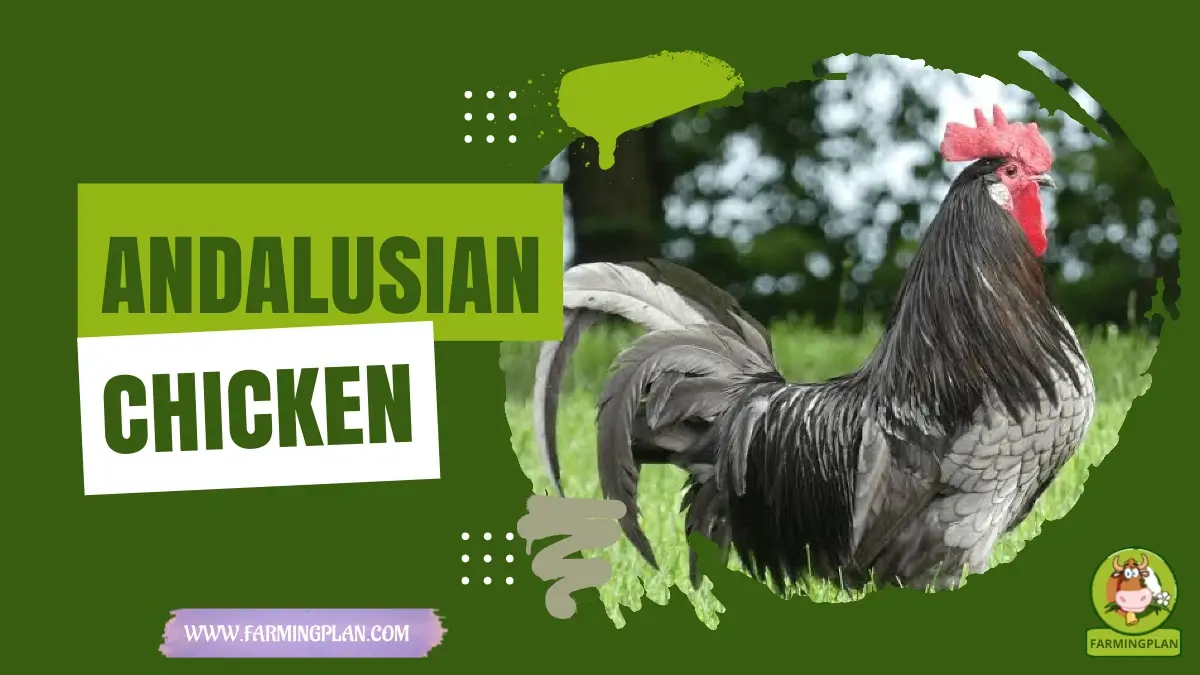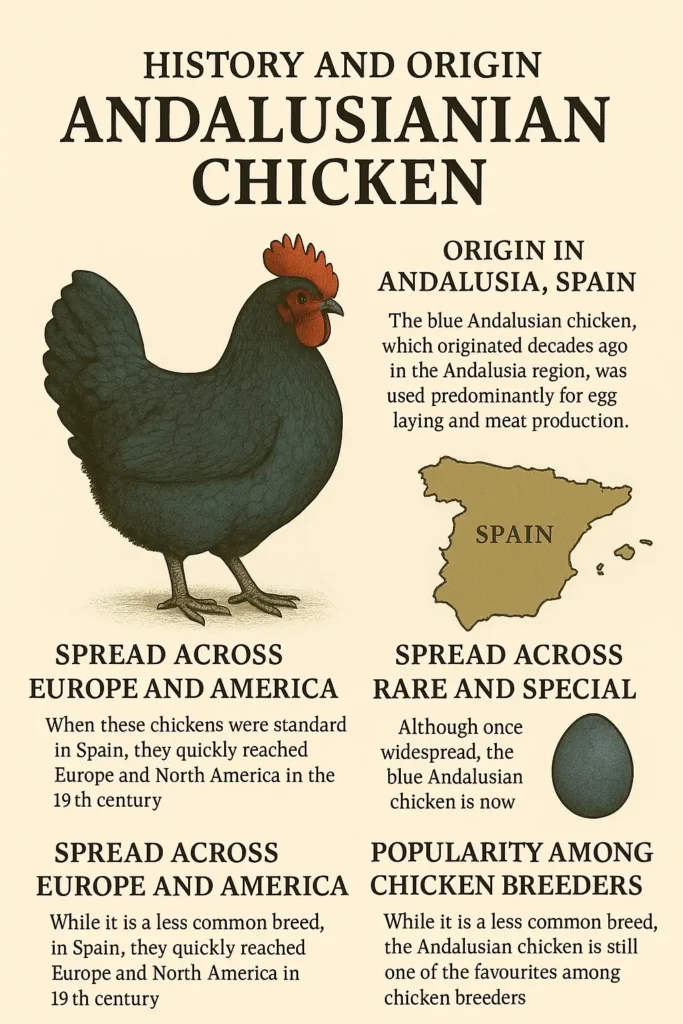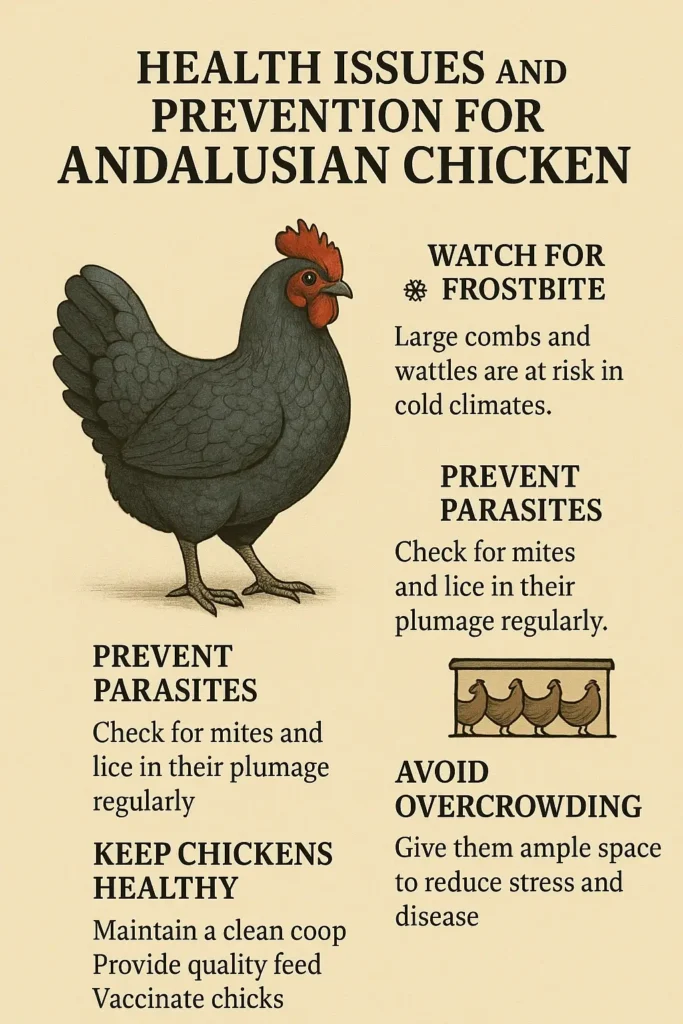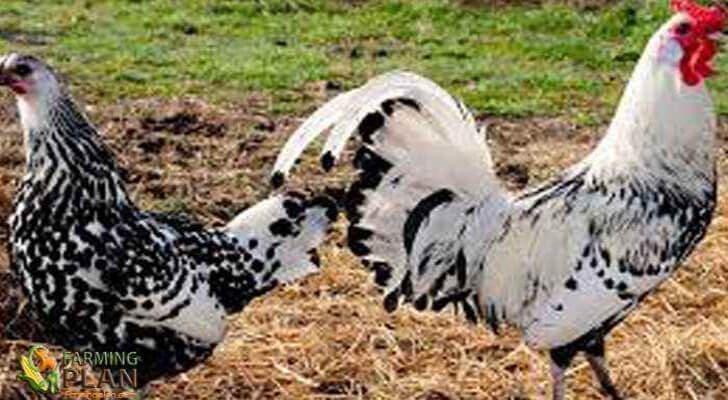Any bird lover seeking bright plumage and entertaining personality should consider owning an Andalusian Chicken. These visually striking birds with blue plumage originate from Spain, where they now gain widespread popularity among owners bre, elders, and farmers. The Blue Andalusian is not just a sight to behold—it’s also a hardy bird that can thrive in various climates and lay many eggs. Whether starting a small backyard coop or adding to your farm, this skittish chicken breed brings charm and productivity. In this guide, we’ll explore everything about these Blue-colored birds, from their unique features to how you can easily raise them at home.

History & Origin of Andalusian Chicken
After descending from free-ranging Castilian breeds, the Andalusian chicken once ruled the warm Andalusian territory within southern Spain. The Andalusian breed resulted from free-ranging Castilian domestic fowl that populated Spanish country lands. The early birds developed into what we know today as landrace chickens, which form an honorable testament to their pure evolutionary process among the free birds.

In the mid-1800s, a poultry expert named John Taylor brought these birds from Spain to England. He noticed their unusual blue ground color and started breeding them carefully. With time, breeders in England developed what we now know as the Blue Andalusian. They focused on creating the perfect feather pattern—what many call the finest color in blue chickens today.
These chickens quickly became popular because of their lovely looks and active nature. The breed spread across Europe and later reached America, where farmers loved their strong egg-laying and cold-weather strength. Even though they’ve changed a bit from the original birds, their roots in Spain still shine through. Today, whether you call them Blue Andalusian Chickens or simply Andalusians, these birds are a stunning reminder of the beauty that careful breeding and history can bring together.
Reads More: Yokohama Chicken: 7 Amazing Features That Will Impress You
Characteristics of Andalusian Chicken
The Andalusian Chicken is one of the most beautiful birds ever. Its blue color is what makes it stand out in any flock. But here’s something cool—not all Andalusians are blue! When you hatch a group of blue chicks, you’ll also get black offspring and splash chicks. This is called color segregation, and it’s typical for this breed.
The Blue Andalusian has soft, shiny feathers with blue-laced plumage. Some birds have more solid slate-blue plumage, while others show off black splashes or light splash colors. These patterns give each bird its special look. Many breeders aim for the ideal feather color: soft blue ground and sharp dark lacing. These chickens have smooth white skins, red combs, and clean yellow legs. The Andalusian pullets and blue males grow into medium-sized chickens, usually weighing five to seven pounds. Their bodies are slim, and their tails are high, giving them a graceful shape.
Whether you pick a Splash Andalusian Cockerel, a White Blue Andalusian Pullet, or a deep black plumage bird, you’re choosing a breed that’s not only pretty but also full of variety. Every time you raise a batch, you get a surprise mix of black, blue, and splash birds. That makes them fun and exciting for breeders and hobbyists alike.
Nature & Temperament of Andalusian Chicken
The Andalusian Chicken is full of energy. These bluebirds are always on the move, exploring their surroundings with curiosity. They love to roam, scratch, and stay busy all day. That makes them great for free-range setups with space to run around. But keep in mind—they can be a little shy. This breed is known as a skittish chicken breed, which means they don’t always enjoy being held or cuddled. They aren’t aggressive, just nervous around people they don’t know well. If you want to tame them, it helps to start when they’re still baby chicks. Regular, gentle handling can make them more friendly over time.
Blue Andalusian Chickens get along well with other chickens but might not do great in tight spaces. They like room to move, and too much crowding can stress them out. These gorgeous birds are intelligent, alert, and fast on their feet. They’ll often spot danger early and warn the flock. If you’re a pet owner looking for a pretty, active chicken or a farmer wanting a bird that can care for itself, this breed is a strong choice. Give them space, freedom, and a safe coop; they’ll reward you with fun personalities and fresh eggs.
“Why did the chicken cross the yard? Because it’s an Andalusian—too beautiful to stay in one place!”
Food & Diet for Andalusian Chicken
Proper feeding keeps your Andalusian Chicken healthy and active and allows it to lay strong eggs. These birds need a balanced diet of protein, vitamins, and clean water. Their food needs change as they grow from baby chicks to full-grown hens and roosters. When they’re young, feed them chick starter crumbles high in protein. This helps their feathers and bones grow strong. As they get older, they switch to layer pellets or crumbles.
These feeds contain calcium and other nutrients that help with egg production and shell strength. You can also give them grains, vegetables, and fruits. Chopped greens like lettuce, spinach, or even herbs like tarragon are healthy treats. Avoid feeding them onions, chocolate, salty snacks, or anything spoiled. These can hurt their health.
Some farmers even mix a bit of chicken stock into warm grains in cold weather. It’s a nice boost, especially in chilly climates. Always make sure they have access to clean, fresh water. Chickens drink a lot—especially in summer. And remember, while skinless chicken breasts might be a meal for humans, your Andalusians are happiest with cracked corn, layer feed, and some love from the garden. A well-fed Blue Andalusian is not just healthy—it’s productive, active, and simply glowing with that blue plumage shine.
Usage & Purpose of Andalusian Chicken
The Andalusian Chicken is more than just a pretty face. Pet owners, hobbyists, and farmers love these feathered birds for many reasons. One of their main strengths is egg-laying. Blue Andalusians are steady layers of medium to large white eggs that lay through most of the year—even in cooler weather. This breed is rarely raised for meat, but some still enjoy their tender bodies. A full-grown Andalusian male or pullet gives a light, lean meat, similar to a pound chicken breast. However, most people keep them for eggs or beauty, not for the table.

Their bright blue color and elegant look make them stars in poultry shows. Many people love showing Andalusian offspring—especially the ones with striking blue-laced plumage. Judges admire their posture, shine, and color variety. Because they’re strong flyers and enjoy roaming, they do best in open areas or secure free-range yards.
That’s why farmers like them for pest control. These birds scratch up bugs, clean the soil, and add life to any garden or farm. Whether you’re showing off a Splash Andy in a bird show or collecting fresh eggs for breakfast, these original birds bring purpose and charm to every setting.
Special Features of Andalusian Chicken
The Andalusian Chicken stands out from the flock with some truly special traits. First and most famous is its blue plumage. The soft, shiny slate-blue feathers with dark lacing make this bird one of the most gorgeous birds in the poultry world. This rare coloring doesn’t appear in every breed, making the Blue Andalusian extra special.
Another cool thing is the color segregation. When you hatch Blue Andalusian Chickens, you don’t just get blue. You also get black and splash offspring in the same batch. That means every hatch gives you a mix of feather styles—solid, spotted, or shaded. Breeders love this surprise factor because it creates new looks for each generation.
These birds are also known for being cold-hardy. Even though they come from sunny Spain, they handle cold climates well, thanks to their active bodies and strong health. They keep laying eggs when other breeds slow down in winter. And they’re smart. These Blue chickens are quick to spot danger, curious about their surroundings, and fun to watch. They bring color, movement, and life to any coop or backyard.
Health Issues & Prevention for Andalusian Chicken
The Andalusian Chicken is a strong and healthy breed, but like all feathered birds, it still needs good care to stay in top shape. These chickens don’t usually get sick easily, but there are a few common problems you should watch out for. One thing to check often is their comb and wattles, especially in cold climates. Because of their size, these areas can get frostbite. To protect your birds, keep your coop dry and draft-free in winter.

Also, look out for mites and lice in their feathers. These tiny bugs hide in the blue plumage, making chickens itchy or weak. To keep pests away, clean the coop often, give them dust baths, and use natural sprays. Blue Andalusian Chickens are active, so they need enough space to move. If they get crowded, they can become stressed, which makes them easier targets for disease. Always give them clean water, fresh feed, and space to scratch and roam.
Watch for signs like low energy, pale combs, or runny droppings. These can mean trouble. Quick action can stop a small problem from becoming a big one. Also, baby chicks should be vaccinated early and stick to a healthy schedule. This builds their immunity and helps prevent diseases before they start. A clean coop, good feed, and regular checkups can keep your beautiful birds healthy, happy, and laying eggs all year.
Reads More: California Gray Chicken: 7 Essential Care Tips for Success
How to Raise Andalusian Chicken Step by Step
Raising Andalusian Chickens is fun and rewarding. Whether you’re a pet owner, hobbyist, or farmer, these steps will help you care for your blue chicks and grow healthy, happy birds.
Step 1: Set Up a Safe Brooder for Chicks
Start with a warm, clean brooder for your baby chicks. Use a heat lamp to keep the space at 95°F during the first week. Drop the temperature by 5°F each week until they are ready for outdoor life. Add soft bedding, chick feed, and fresh water.
Step 2: Feed High-Quality Starter Crumbles
Feed your chick’s starter feed with at least 18% protein. This helps with fast growth and feather development. Never feed moldy or wet food—it can make them sick.
Step 3: Move Them to a Secure Coop
At 6–8 weeks, move the chicks to a coop. Ensure the coop has strong fencing, dry bedding, and good airflow. These blue-colored birds can fly, so cover the run or make the fence tall enough.
Step 4: Offer Layer Feed and Grit
Once the hens start laying, switch to layer pellets or crumbles. Add grit to help them digest food. You can also give healthy treats like grains, veggies, and herbs such as tarragon.
Step 5: Give Them Space to Roam
Blue Andalusian Chickens love to roam. Let them free-range safely, or give them a big run. This keeps them active and stops boredom.
Step 6: Check for Health Weekly
Look at their eyes, feet, and feathers once a week. A shiny coat, clean feet, and alert eyes are signs of a healthy bird. Dust for mites if needed.
Step 7: Collect Eggs Daily
They lay white eggs regularly. To keep them clean and fresh, pick them up daily and store them in a cool place.
Step 8: Watch for Feather Colors in Offspring
When hatching eggs, expect a mix of blue offspring, black offspring, and splash birds. Each chick is a surprise! With love, attention, and care, your Andalusian Chickens will grow into healthy, strong, and gorgeous birds.
Expert Tips and Best Practices for Raising Andalusian Chickens
Raising Andalusian Chickens becomes even easier with a few smart tips from seasoned breeders and farmers. These birds are strong and lively, but knowing what works best can help them truly shine.
Choose hatchery colors wisely.
When picking chicks, remember you’ll get a mix of blue, black, and splash colors. If you aim for show-quality birds, choose chicks with clean blue ground color and strong lacing. That’s the finest color that wins ribbons.
Keep your coop clean and dry.
Moisture and dirt can lead to disease. A clean coop with dry bedding keeps your feathered birds healthy and stress-free. Add fresh straw weekly and air out the space often.
Avoid overcrowding
Andalusians like space. Keep fewer birds in tight spaces to prevent pecking, boredom, and health issues. These birds are not made for cages—they want room to move.
Offer shade and shelter in all seasons.
Though they handle cold climates, they also need protection from hot summer sun. Make sure they have a shady spot and fresh water at all times.
Watch the flock for changes.
Behavior can tell you a lot. If a usually active blue male starts hiding or a blue chick looks sleepy, check on them immediately. Early action can stop problems quickly.
Breeding tip: Pair strong, clean-colored birds to increase your chance of hatching ideal feather chicks. The black, splash, and blue mix keeps things fun, but brilliant pairing brings out the best traits. With these easy tips, your Blue Andalusian flock will stay happy, healthy, and stunning all year round.
FAQs
1. What color eggs do Andalusian chickens lay?
Andalusian chickens lay medium to large white eggs. Their egg production is consistent, often continuing through winter months.
2. Are Andalusian chickens good egg layers?
They are prolific layers, producing approximately 150 to 200 eggs annually. Their consistent laying makes them valuable for small-scale egg farming.
3. What is the temperament of Andalusian chickens?
Andalusian chickens are active and alert but can be flighty. They prefer free-ranging environments and may become stressed in confinement.
4. Are Andalusian chickens suitable for cold climates?
The large combs on these birds put them at risk for frostbite in cold environments, although they are naturally durable creatures. Proper shelter and warmth protection are fundamental for bird survival during cold winter months.
5. Do Andalusian hens go broody?
Andalusian hens rarely go broody, making them less inclined to sit on eggs. For breeding purposes, it is recommended that an incubator or a broody hen of another breed be used.
Conclusion
Any backyard flock gains substantial value from including the Andalusian Chicken, which displays vibrant blue feathers and natural movement abilities. The Andalusian breed maintains frequent egg production of medium and large white eggs because it adapts to free-range environments and works in various temperature zones when well-sheltered. These chickens produce easy-to-collect eggs since they do not brood often, remain very sturdy, and represent a favored choice for poultry aficionados because of their distinctive look.


